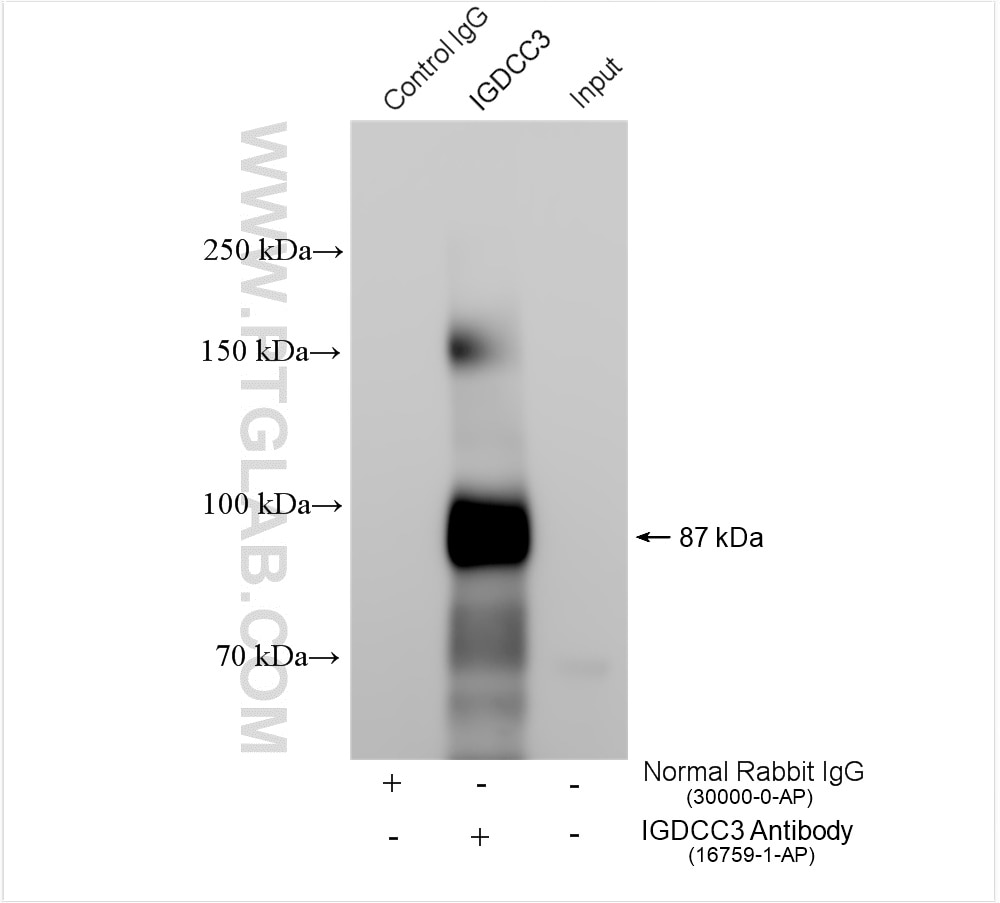IGDCC3 Polyclonal antibody
IGDCC3 Polyclonal Antibody for IP, ELISA
Host / Isotype
Rabbit / IgG
Reactivity
human, mouse, rat
Applications
IP, ELISA
Conjugate
Unconjugated
Cat no : 16759-1-AP
Synonyms
Validation Data Gallery
Tested Applications
| Positive IP detected in | human placenta tissue |
Recommended dilution
| Application | Dilution |
|---|---|
| Immunoprecipitation (IP) | IP : 0.5-4.0 ug for 1.0-3.0 mg of total protein lysate |
| It is recommended that this reagent should be titrated in each testing system to obtain optimal results. | |
| Sample-dependent, Check data in validation data gallery. | |
Product Information
16759-1-AP targets IGDCC3 in IP, ELISA applications and shows reactivity with human, mouse, rat samples.
| Tested Reactivity | human, mouse, rat |
| Host / Isotype | Rabbit / IgG |
| Class | Polyclonal |
| Type | Antibody |
| Immunogen | IGDCC3 fusion protein Ag10276 相同性解析による交差性が予測される生物種 |
| Full Name | immunoglobulin superfamily, DCC subclass, member 3 |
| Calculated molecular weight | 814 aa, 87 kDa |
| Observed molecular weight | 87 kDa |
| GenBank accession number | BC067107 |
| Gene symbol | IGDCC3 |
| Gene ID (NCBI) | 9543 |
| RRID | AB_3669255 |
| Conjugate | Unconjugated |
| Form | Liquid |
| Purification Method | Antigen affinity purification |
| Storage Buffer | PBS with 0.02% sodium azide and 50% glycerol pH 7.3. |
| Storage Conditions | Store at -20°C. Stable for one year after shipment. Aliquoting is unnecessary for -20oC storage. |
Background Information
IGDCC3, also known as PUNC, is a transmembrane protein that belongs to the immunoglobulin (Ig) superfamily (PMID: 9507132). IGDCC3 contains 4 C2-type Ig-like domains and 2 fibronectin type III repeats. It is highly expressed in the developing embryo in nervous system, limbs, and inner ear (PMID: 9922388; 9507132). IGDCC3 may be involved in the cerebellar control of motor coordination (PMID: 11486040). It has also been associated with tumorigenic mechanism and prognosis of cholangiocarcinoma (PMID: 36979826).
Protocols
| Product Specific Protocols | |
|---|---|
| IP protocol for IGDCC3 antibody 16759-1-AP | Download protocol |
| Standard Protocols | |
|---|---|
| Click here to view our Standard Protocols |


